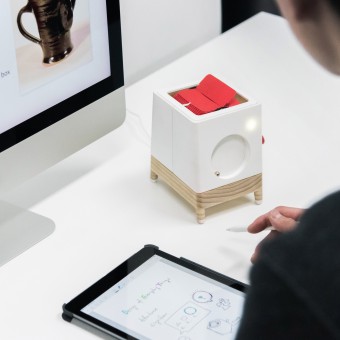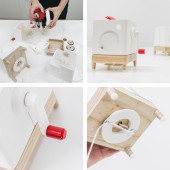FlipMe Learning Companion Online Learning Companion by Wondo Jeong |
Home > Winners > #77554 |
 |
|
||||
| DESIGN DETAILS | |||||
| DESIGN NAME: FlipMe Learning Companion PRIMARY FUNCTION: Online Learning Companion INSPIRATION: Millions of people around the world now use online learning as a convenient and inexpensive alternative to classroom based education. Despite these advantages, online courses suffer from high dropout rates. Prior research into online learning suggested limited opportunities for social interaction between students may contribute to these high dropout rates. In order to address this challenge we present FlipMe, an Internet of Things, IoT, companion augmenting peer to peer interaction through a tangible interface in real time. UNIQUE PROPERTIES / PROJECT DESCRIPTION: FlipMe is an IoT, Internet of Things, companion that aims to augment peer to peer interaction in real time for more active and interactive online learning. Through a user validation study, we observed that FlipMe's tangible interfaces and embodied feedback, such as flipping book metaphor, promoted interaction between paired peers during online learning activities over distance. Thus FlipMe's unique approach promotes enriched communication for students compared to conventional online learning services providing textual information, for instance, through a discussion board. OPERATION / FLOW / INTERACTION: FlipMe physicalizes peer’s learning activities. A flipping top provides real-time feedback through a reading a book like motion, triggered by a paired peer’s viewing of video content. Group study activities are expressed through a rolling ball feedback. A rotatable handle provides a nudging function for peer to peer interaction. Thus FlipMe conveys information between peers through a more memorable and intuitive design approach compared with traditional screen-based interfaces associated with online learning, with their limitations of conventional interactions through keyboard or mouse. PROJECT DURATION AND LOCATION: The project begun in March 2018 and finished in February 2019. The project was conducted at UNIST, Ulsan National Institute of Science and Technology, Republic of Korea. |
PRODUCTION / REALIZATION TECHNOLOGY: We utilized different fabrication techniques ranged from 3D printing to computer numerical control, CNC, for high fidelity prototype that aims to approximate, in detail, aesthetic and functional characteristics. Firstly, Ash was selected to provide the natural beauty of grain. In order to prevent breakage during CNC machining, a minimum thickness was kept in 6mm. While machining, grooves were made for a peripheral design where the electronic parts such as motors were inserted. In addition, a neodymium magnet with a diameter of 8mm was used to provide information of progress of the common goal to the front side of the body. In order to implement the movement of the ball type magnet, two gears with a ratio of 1 to 1 and diameter of 32mm were laser cut and plugged in at 180 degrees to a servo motor. As the servomotor starts to turn, the plugged gear transmits rotation to a second gear installed with the plate on the backside of the circular embossing area. To design the flipping card mechanism, 1mm polycarbonate sheet was selected and cut. Mat red finish was applied. A small aluminium needle was designed to hold and release the flipping card. In total, 48 finished cards were used to provide flipping feedback of peer’s learning activity. Finally, to rotate the cards, a timing belt and a pulley with 15 cogs was used as power-train from a step motor. The design of the handle includes a 360 degree rotary encoder module, or Grove Encoder, to sense the number of rotations and transmit to the microcontroller board, 511 Nucleo L432KC. This provided the same pattern and number of rotations to a paired FlipMe product. SPECIFICATIONS / TECHNICAL PROPERTIES: For the physical product: Width 100mm x Depth 100mm x Height 144mm, and the inclination is 86° so that the user can easily observe the main interfaces to the top and at the front. In terms mobile application design: The portrait view is 1125x2436 px and the landscape view is 2436x1125 px which are considered the latest model of iPhone. TAGS: Online Learning, Interpersonal Communication, Tangible Interface, Peer Learning RESEARCH ABSTRACT: 1. Type: An in-lab study 2. Objectives: To evaluate FlipMe’s potential to stimulate peer to peer communication when engaging online video content. 3. Method: Entry question, video observation and open discussion session between participants and a final retrospective interview. 4. Data Collection: Quantitative data logged onto an internet server, together with transcribed interview responses and video recordings. 5. Participants: 8 females and 14 males with an age range of 22 to 32 years old. 6. Insights: Tangible interfaces showed the potential to encourage more active engagement in peer learning activities during online learning when viewing video contents. CHALLENGE: We had a challenge to implement real time parallel control between two products for paired peers unlike the usual IoT devices which communicate unidirectionally. Consequently, we had a lack of the user study duration, thus the long-term, ethnographic deployment study in users' real lives was not conduct. Future planned in the wild studies will provide a more contextualized understanding of FlipMe’s potential for fostering communication within online learning spaces. ADDED DATE: 2019-02-19 17:18:43 TEAM MEMBERS (6) : James Self, Hui Sung Lee , Ian Oakley, Young-chul Chung, Byounghern Kim and Sangjin Park IMAGE CREDITS: Wondo Jeong, 2018. PATENTS/COPYRIGHTS: Patent Number: 10-2019-0023310 Patent Holder: UNIST, Inventors: Wondo Jeong Year: 2019 Jurisdiction: South Korea |
||||
| Visit the following page to learn more: http://www.wondo.xyz/ | |||||
| AWARD DETAILS | |
 |
Flipme Learning Companion Online Learning Companion by Wondo Jeong is Winner in Education, Teaching Aid and Training Content Design Category, 2018 - 2019.· Read the interview with designer Wondo Jeong for design FlipMe Learning Companion here.· Press Members: Login or Register to request an exclusive interview with Wondo Jeong. · Click here to register inorder to view the profile and other works by Wondo Jeong. |
| SOCIAL |
| + Add to Likes / Favorites | Send to My Email | Comment | Testimonials | View Press-Release | Press Kit |
Did you like Wondo Jeong's Education Design?
You will most likely enjoy other award winning education design as well.
Click here to view more Award Winning Education Design.








